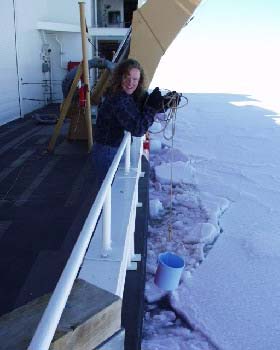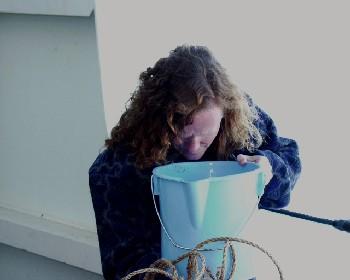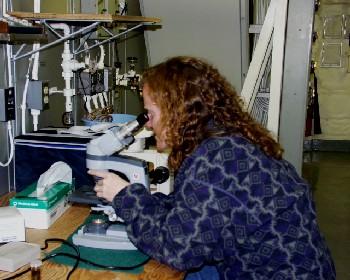12 June, 2000
What's that brown stuff?
As the Healy began to enter the ice flows, I started to notice a brown
sludge on the bottom layer of the chunks of ice that popped up from below
the sides of the ship. Being from Nome, I had an idea of what that "stuff"
was, since the Bering Sea also freezes over during the wintertime. Luckily
my Principal Investigator Lisa Clough, a.k.a. "The Mud Lady", was able to
help me with some basic knowledge of this "Ice Algae." Now that I have said
I have some basic knowledge, I will tell you that ice algae has not been
studied by scientists to any great extent, so many of the ideas I will
present are just that, ideas.
Where in the world did this stuff come from?
Some scientists speculate that diatoms may envelop themselves in cysts
(develop a hard outer covering) to "winter over", as a means of survival.
Other scientists believe that they may survive on organic matter and may
also store lipids (fats) for food during the cold winter months.
Regardless, as the sea ice begins to thin, and probably more import the
layer of snow on top of the ice is reduced, more photosynthetic light can
reach the bottom layers of the ice. Ice algae usually begins to appear on
the bottom of sea ice around the month of March. Since ice algae is made up
of single celled organisms known as diatoms, it is dependent on light for
the process of photosynthesis to produce food. The diatoms then can begin
to produce food efficiently and begin to reproduce, forming net-like layers
under the ice.
Why are they so abundant?
. As more light reaches the bottom layer, the algae begins to reproduce
rapidly, causing an algal bloom. Diatoms require red and blue wavelengths
of light energy for the process of photosynthesis, as well as nitrogen,
phosphorus, and silica. They reflect the green wavelengths; therefore we
see them as green in color. As these algal blooms develop, more and more
carbon dioxide is taken in to produce sugars and oxygen. The water tends to
be already saturated with oxygen, therefore the oxygen given off forms
bubbles that rise to the bottom layer of the ice. As these bubbles of
oxygen move around, it is thought that they may scrap the layers of algae
off of the ice, making the algae form long communal strands. In the Chukchi
Sea north of Alaska, these strand have been observed by submersible ROV's to
be 20 to 30 feet in length. They have been described as an upside down kelp
forest. Amazingly, these colonies may easily contain over 200 species of
diatoms.
How do these long strands hold together?
The diatoms form a mucous that seem to be the "glue" that holds them
together. Again, there are many ideas of what the main purpose of this
mucous is. Diatoms benefit from this mucous; because it gives the colonies
buoyancy and helps them stay together. The drawbacks to the formation of
this mucous is the fact that it tends to block out needed carbon dioxide and
it may also block the elimination of wastes produced during photosynthesis.
Mucous also is rich in nitrogen, meaning it requires are large supply of
nitrogen to form. If you ever have the opportunity to touch ice algae, you
will see that is does in fact feel like secretion from a runny nose.
By this time you might be saying, "So what's the big deal?"
Well, ice algae is the beginning of the Arctic food chain. Ice algae are
eaten by zooplankton, which are in turn eaten by krill and small
crustaceans. They are, in turn eaten by small fish such as the Polar Cod,
which are then eaten by birds and seals. And at the top of food chain is
the Polar Bear. With little research being done, scientists are unsure of
just how important ice algae is to the overall arctic ecosystem. Some
studies suggest that the ice algae are responsible for only 10% of the total
primary production of sugars from carbon dioxide (carbon cycling), while
others have put the value at 80%.
There are many unanswered question about how this algae functions in the
arctic environment and what role it plays in the overall health of the
ecosystem. With so many questions remaining, you can be sure that more
intensive and extensive research will be done in the future.
Todd

Lisa brings up the bucket from below.

A close inspection.

Lisa is identifying species of diatoms.
Contact the TEA in the field at
.
If you cannot connect through your browser, copy the
TEA's e-mail address in the "To:" line of
your favorite e-mail package.
|
